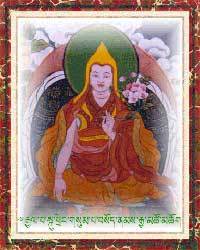4 CENTRAL ASIA
In 1505, the Uzbeks, a Turkic-speaking people living in the steppes of modern-day Uzbekistan, Kazakhstan, and parts of Turkmenistan, invaded the south-central region of Samarkand, Bukhara, and Tashkent, including Khorezm, marking a significant shift in Central Asia’s political landscape. This led to the establishment of the Shaybanid dynasty, which consolidated power and contributed to the Timurid Empire’s political fragmentation. The Uzbeks expanded their influence over the Silk Road trade routes, impacting regional commerce and politics. Meanwhile, in Tibet, Sonam Gyatso (1543-1588) was bestowed the title “Dalai Lama” by a 16th-century Mongol ruler, solidifying the Dalai Lama lineage’s spiritual and political authority and aligning Tibetan Buddhism with Mongol interests.
Sonam Gyatso is the first to have the title Dalai Lama. He was born in 1543 near Lhasa. (Source: Wikimedia)
Further north, Altan Khan (1507-1582), a revived Mongol leader, pressured the Ming Dynasty of China, leading to skirmishes and diplomatic negotiations. His efforts were part of a broader Mongol resurgence and influence in Central Asia, affecting regional dynamics. In the west, Cossack chieftain Yermak Timofeyevich’s late 16th-century incursion into Siberia marked the beginning of Russian eastward expansion, leading to the establishment of Russian dominance in Siberia.
In 16th century Central Asia, ordinary people lived simple lives, often centered around agriculture, herding, or trade. In rural areas, families lived in small villages or nomadic encampments, relying on subsistence farming and animal husbandry. They grew crops like wheat, barley, and millet, and raised livestock like sheep, goats, and camels. In urban centers, artisans and merchants sold their wares in bustling markets, while women managed households and raised children. People celebrated local festivals and observed Islamic traditions, and storytelling and music were integral parts of community life. Despite the political upheavals and power struggles, ordinary people maintained their cultural heritage and resilience, passing down traditions and customs to future generations.

